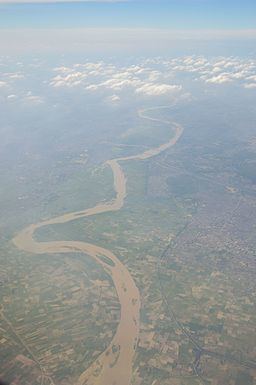Length 400 km Basin area 7,083 km² | Basin area 7,083 km² | |
 | ||
- location Saharanpur district, India | ||
Cancer yatra ground report on hindon river of uttar pradesh
Hindon River, a tributary of Yamuna river, is a river in India that originates in the Saharanpur District, from Upper Shivalik in Lower Himalayan Range. The river is entirely rainfed and has a catchment area of 7,083 square kilometres (2,735 sq mi).
Contents
- Cancer yatra ground report on hindon river of uttar pradesh
- Map of Hindon River Uttar Pradesh
- Black and red waters of hindon river near delhi dirty flows my river
- Tributary
- Mythology
- History
- Hindon Vahini
- References
Map of Hindon River, Uttar Pradesh
It flows between Ganges and Yamuna rivers, for 400 kilometres (250 mi) through Muzaffarnagar District, Meerut District, Baghpat District, Ghaziabad, Noida, Greater Noida before it joins Yamuna river just outside Delhi. The Hindon Air Force Base of the Indian Air Force also lies on its bank in the Ghaziabad district on the outskirts of Delhi.
Black and red waters of hindon river near delhi dirty flows my river
Tributary
Kali river, which originates in the Doon Valley and travels about 150 kilometres (93 mi) passing through Saharanpur, Muzaffarnagar, Meerut and Bagpat districts, merges with Hindon River, before it merges with the Yamuna River. The Kali river is also highly polluted and adds to the pollution of the Hindon, as it passes through populated and industrial belt of Uttar Pradesh.
These days the Ghaziabad Nagar Nigam has taken serious steps to beautify the river banks.
Mythology
Near Sardhana lies the ancient Mahadev Temple that is believed to be dating from the Mahabharata period, and where the Pandavas prayed before leaving for the Lakshagrih, the notorious palace made of lac by Duryodhana, at the confluence of the Hindon (previously known as Harnandi) and Krishna rivers (Kali River, Kali Nadi) at Varnavrat, the present Barnava, and where the prince resided with their mother Kunti.
History
An Indus Valley Civilization (fl. 3300–1300 BCE) site, Alamgirpur is along the Hindon River, 28 kilometres (17 mi) from Delhi.
In 1857 to 1858, the Ghaziabad city was the scene of fighting during the Indian Mutiny, when Indian soldiers in the Bengal Army that was under the British East India Company mutinied but soon turned into a widespread uprising against British rule in India. The Hindon River, in particular, was the site of several skirmishes between Indian troops and British soldiers in 1857 including the Battle of Badli-ki-Serai and today, the graves of the British soldiers and officers can still be seen. Ghaziabad’s place in Northern Indian history is assured by the birth of many freedom fighters who played a role in various revolutions all dedicated to the attainment of freedom for all who have lived – and are still living – there.
Hindon Vahini
The industries of western Uttar Pradesh discharge their effluents, often with no treatment, directly into the ganga River. This heavy loading characteristics the presence of toxic contaminants and for biological diversity of river ecology. Dissolved oxygen levels are zero throughout the length of this river.
